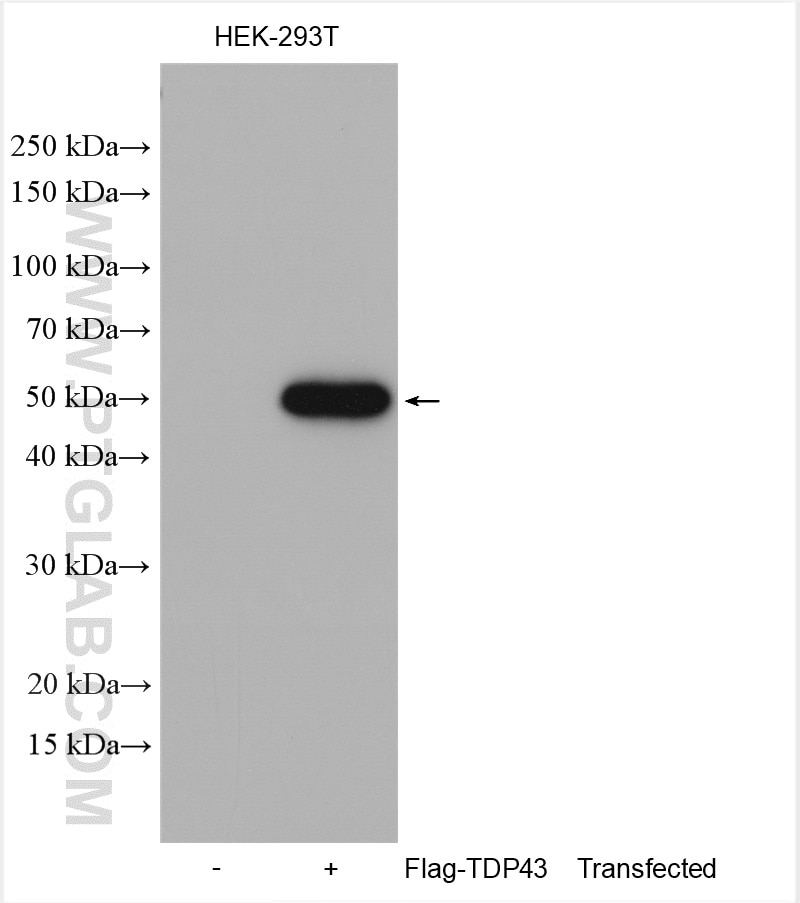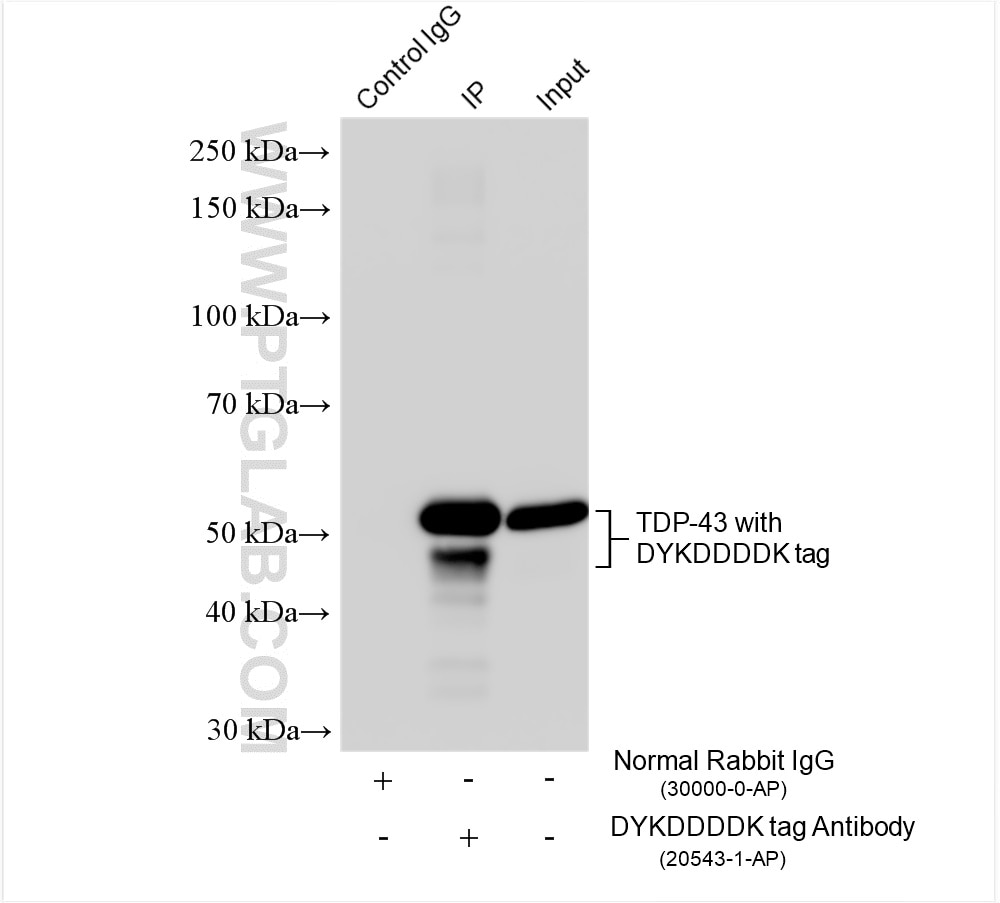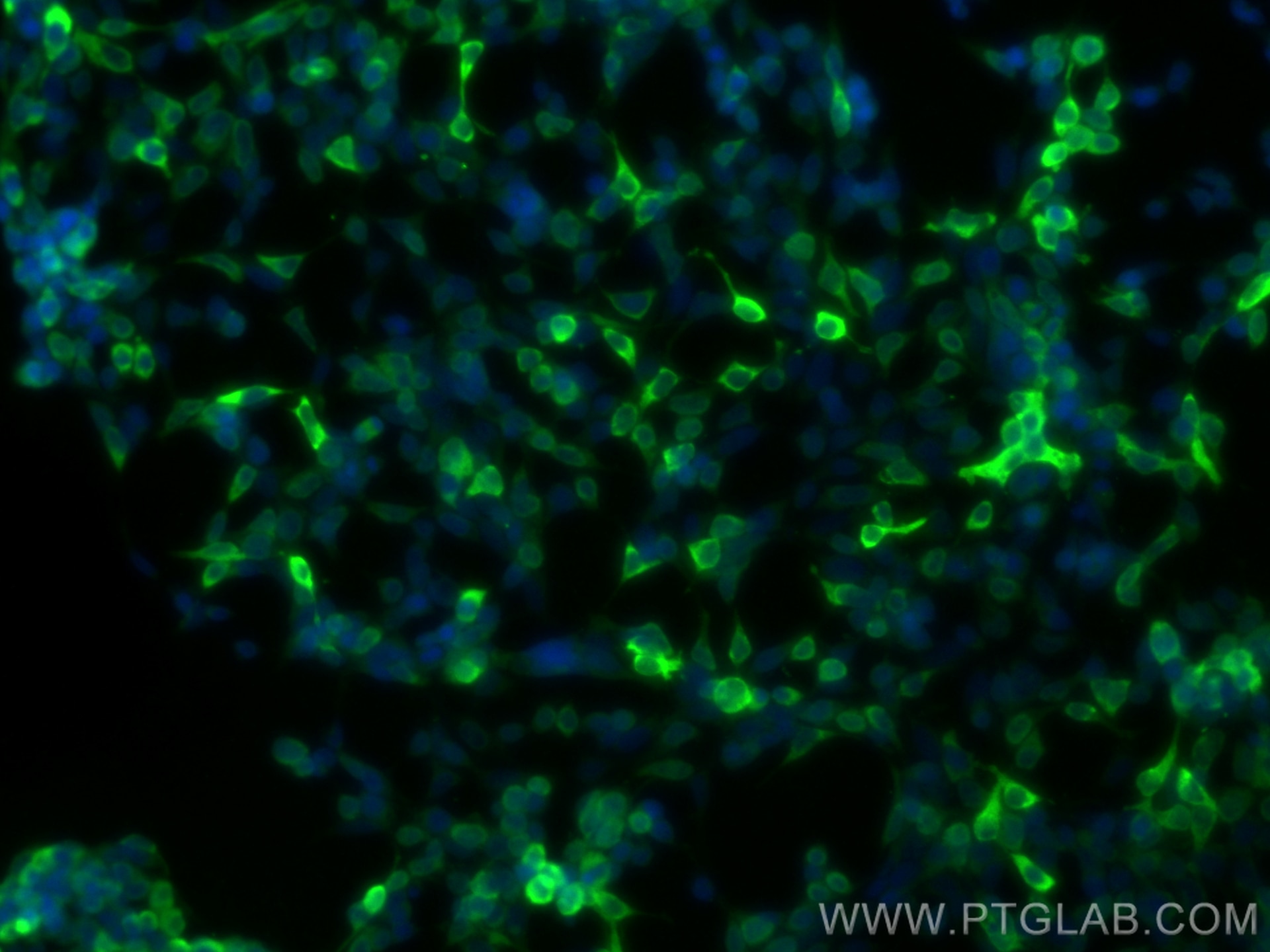Validation Data Gallery
Tested Applications
| Positive WB detected in | Transfected HEK-293T cells |
| Positive IP detected in | Transfected HEK-293 cells |
| Positive IF/ICC detected in | Transfected HEK-293 cells |
Recommended dilution
| Application | Dilution |
|---|---|
| Western Blot (WB) | WB : 1:20000-1:100000 |
| Immunoprecipitation (IP) | IP : 0.5-4.0 ug for 1.0-3.0 mg of total protein lysate |
| Immunofluorescence (IF)/ICC | IF/ICC : 1:200-1:800 |
| It is recommended that this reagent should be titrated in each testing system to obtain optimal results. | |
| Sample-dependent, Check data in validation data gallery. | |
Product Information
20543-1-AP targets DYKDDDDK tag in WB, IHC, IF/ICC, IP, CoIP, ChIP, RIP, ELISA applications and shows reactivity with recombinant protein samples.
| Tested Reactivity | recombinant protein |
| Cited Reactivity | human, mouse, pig, silkworm |
| Host / Isotype | Rabbit / IgG |
| Class | Polyclonal |
| Type | Antibody |
| Immunogen |
CatNo: Ag2329 Product name: Recombinant DYKDDDDK tag protein Source: e coli.-derived, PGEX-4T Tag: GST Sequence: DYKDDDDK 相同性解析による交差性が予測される生物種 |
| Full Name | DYKDDDDK tag |
| Gene Symbol | |
| Gene ID (NCBI) | |
| RRID | AB_11232216 |
| Conjugate | Unconjugated |
| Form | |
| Form | Liquid |
| Purification Method | Antigen affinity purification |
| UNIPROT ID | FLAGTAG |
| Storage Buffer | PBS with 0.02% sodium azide and 50% glycerol{{ptg:BufferTemp}}7.3 |
| Storage Conditions | Store at -20°C. Stable for one year after shipment. Aliquoting is unnecessary for -20oC storage. |
Background Information
Protein tags are protein or peptide sequences located either on the C- or N- terminal of the target protein, which facilitates one or several of the following characteristics: solubility, detection, purification, localization and expression. The DYKDDDDK(FLAG) peptide has been used extensively as a general tag in expression vectors. This peptide can be expressed and detected with the protein of interest as an amino-terminal or carboxy-terminal fusion. N-terminal DDDDK vectors provide an Ek cleavage site for removal of the fusion tag. The DDDDK peptide is likely to be located on the surface of a fusion protein because of its hydrophilic nature. As a result, the DDDDK peptide is more likely to be accessible to antibodies. A DDDDK-tag can be used in many different assays that require recognition by an antibody, such as western blotting, immunocytochemistry, immunoprecipitation, flow cytometry, protein purification, and in the study of protein-protein interactions, cell ultrastructure, and protein localization and so on. This antibody is a rabbit polyclonal antibody raised against 3xFlag (3xDYKDDDDKT) sequence and recognizes the (1x) and (3x)DYKDDDDK peptide and detects DDDDK-tagged proteins. Anti-FLAG is a registered trademark of Sigma-Aldrich Biotechnology.
Protocols
| Product Specific Protocols | |
|---|---|
| IP protocol for DYKDDDDK tag antibody 20543-1-AP | Download protocol |
| WB protocol for DYKDDDDK tag antibody 20543-1-AP | Download protocol |
| Standard Protocols | |
|---|---|
| Click here to view our Standard Protocols |
Publications
| Species | Application | Title |
|---|---|---|
Science Ubiquitination of G3BP1 mediates stress granule disassembly in a context-specific manner. | ||
Signal Transduct Target Ther Trogocytosis of CAR molecule regulates CAR-T cell dysfunction and tumor antigen escape | ||
Cell Ca2+ sensor-mediated ROS scavenging suppresses rice immunity and is exploited by a fungal effector. | ||
Protein Cell Senktide blocks aberrant RTN3 interactome to retard memory decline and tau pathology in social isolated Alzheimer's disease mice | ||
Nat Metab Lactylome analysis suggests lactylation-dependent mechanisms of metabolic adaptation in hepatocellular carcinoma |



